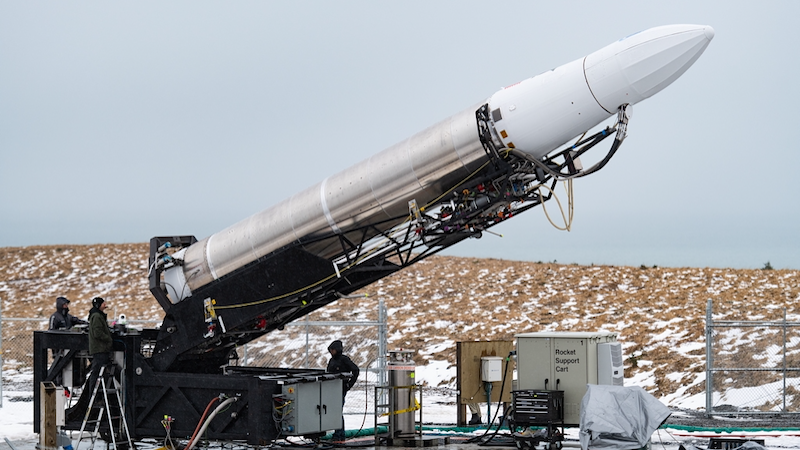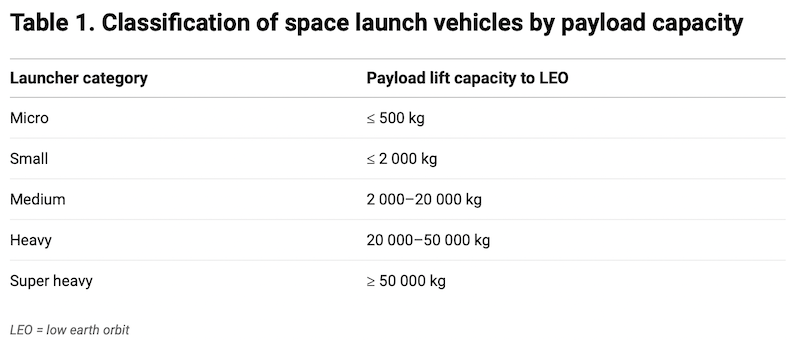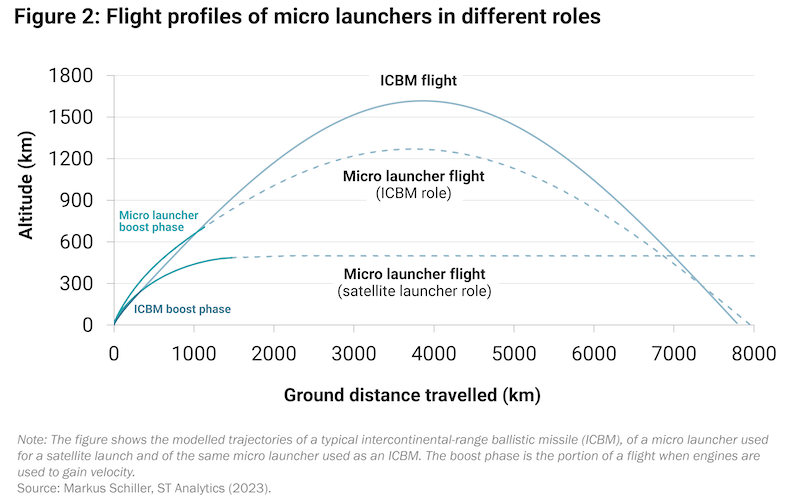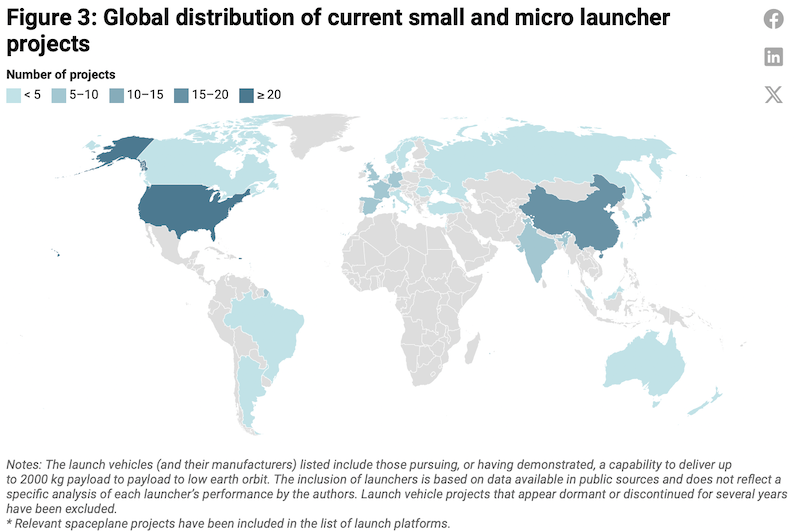Small And Micro Launchers In The NewSpace Era: New Missile Proliferation Risks Or More Of The Same? – Analysis

By Kolja Brockmann and Dr Markus Schiller
The global growth of the NewSpace industry, the demand for launch capacity for small satellites and the desire to reduce launch costs are driving the development of small and micro launch vehicles by commercial providers. The dual-use nature of traditional space launch vehicle technology has always been a missile proliferation challenge. With the larger number and diversity of launch vehicle projects pursued by commercial providers in the NewSpace era, the extent of this challenge appears to be changing.
In general, space launch vehicles of all sizes use many of the same, or at least very similar, technologies and major components as ballistic missiles. A lot of the small and micro launch vehicles currently being developed seek to provide a ‘rapid response’ capability—meaning that they are designed to be deployable at short notice and from a variety of launch locations—making them more similar to ballistic missiles.
This topical backgrounder seeks to create a better understanding of current trends in small and micro launchers and how they contribute to missile proliferation risks. It explains what small and micro launchers are and how their technologies and optimization resemble and differ from those of ballistic missiles. It explores how the availability of small and micro launcher technology could contribute to missile proliferation and how the particular trends in the NewSpace era increase this risk. Finally, it calls on states and industry to work together to reduce the missile proliferation risks linked to small and micro launcher technology.

What are small and micro launchers?
Small (or small-lift) launchers are space launch vehicles usually optimized to carry and insert small satellites into orbit (see figure 1). Space launch vehicles can be classified according to several different characteristics. The most common classification (see table 1) sorts launchers by the weight of the payload they can deliver to low-earth orbit (LEO; c. 160–1000 kilometres altitude). The ‘small’ in small launcher thus refers to the maximum weight of the payload and not the size of the launch vehicle. While there are some variations in definition, small launchers are usually defined as those capable of delivering payloads of up to 2000 kilograms to LEO and micro launchers as those capable of doing so with payloads of up 500 kg. In contrast, the current workhorse of the NewSpace age, SpaceX’s Falcon 9 rocket, is a heavy launcher that can deliver payloads of up to 22 800 kg to LEO.

The basic technical characteristics of any launcher, including small and micro launchers, directly result from its mission requirement: to launch a satellite into space. For a satellite to stay in earth orbit, physics dictates that it has to move around the earth at a certain speed, which depends on the altitude. It should also be high enough to not be slowed down by aerial drag from the atmosphere and ideally travel parallel to the earth’s surface. A space launcher must therefore place an artificial earth satellite in LEO at a speed of 7.8 km/second for a 160 km orbit altitude, or 7.35 km/s for a 1000 km orbit altitude. This speed is called circular velocity. A space launcher is a delivery system capable of accelerating its satellite payload to the intended speed, lifting it to the intended altitude and setting it on the intended course.
Missions and demand for small and micro launchers
With the growth of the NewSpace industry there has been a significant increase in companies offering space-based services, either making use of existing satellite infrastructure or developing and launching new satellite constellations. Advances in satellite technology have made satellites smaller, lighter and to some extent cheaper. With more and more businesses relying on satellites for the services they offer, there is a significant perceived demand for launch services that can be used at short notice and tailored to the delivery of small satellites to specific orbits to enable rapid replacement of dysfunctional satellites. This demand is created by commercial satellite companies, critical infrastructure providers and militaries.
There is also a general demand for more launch capacity, as several older heavy launchers have now been retired and there is limited capacity remaining for small satellites to ‘rideshare’ or ‘piggyback’ along with other, primary, payloads, meaning that such spots usually have to be booked several years in advance. Another indicator of the current demand for small launch capacity is that many companies in the advanced stages of developing a launch vehicle claim to have already filled their books for the first scheduled launches. Even so, there may well be insufficient demand to justify the large number of small and micro launchers currently in development.
Small and micro launcher technology and ballistic missiles
Significant differences between the basic missions and operational requirements of small and micro launchers and those of ballistic missiles may lead to very different design choices and varying technical solutions. Throughout the history of rocket development, many ballistic missiles have been converted into space launchers. The very first launch of a satellite in 1957 used an R-7 intercontinental ballistic missile (ICBM), but no space launcher has ever been directly used in a missile role. There are good reasons for this. Ballistic missiles are weapon systems that come with many specific military requirements, while space launchers must optimize their performance capabilities to reach circular velocity. The traditional design choices for space launchers mean that they do not usually lend themselves to conversion into ballistic missiles. However, the technologies used in small and micro launchers are still highly relevant—albeit differently optimized—for an actor undertaking a missile programme.
Differences between space launchers and ballistic missiles
There are clear differences in the basic requirements of space launchers, including small and micro launchers, and ballistic missiles. Both are delivery systems designed to transport a defined payload to a specific location. A space launcher deploys its payload in a predetermined orbit but, traditionally, the timing of when this happens is secondary and there is less need for accuracy. A ballistic missile, however, must deliver its payload so that it very precisely impacts a predetermined point on (or near) earth’s surface.
Another difference is the stakes involved. A launch failure in the case of a small or micro launcher merely results in possible reputational and monetary costs, while the failure of a missile launch may have a more or less decisive influence on a military operation, the course of a conflict or the stability of a deterrence relationship. In some cases, missiles are not thoroughly tested for reliability, but this often reflects the fact that they are only intended as policy tokens and are not intended to be used in combat.
A space launch can usually wait until the probability of success is highest: in perfect weather conditions, with months or even years of preparation, involving a large, dedicated team of experts and with the option of postponement. In contrast, a small team of soldiers, potentially under attack, should ideally be able to launch a missile at any time, in any weather.
Furthermore, ballistic missiles do not need to reach circular velocity to deliver their payload (see figure 2). Therefore, they do not have to carry along as much propellant as space launchers nor do they have to accelerate to such a high speed, making the technological margins more forgiving.

Finally, ballistic missiles must be built in advance and then deployed or stored, so that they can be used, potentially in large numbers, in a conflict. This requires the establishment of serial production, with proven functionality and reliability and an extensive test programme. In contrast, space launchers can be developed as prototypes and manufactured for specific missions booked months or years in advance, and the design and production processes can still be adjusted for the next launcher.
All of these aspects are reflected in the technologies used in small and micro launchers and ballistic missile systems. It is therefore possible to determine whether a rocket in development is intended to be used as a ballistic missile system or a space launcher. Analysing the engineering choices that stand out and the technologies deployed that are of interest for a military missile programme can help make such a determination.
New capabilities pursued in commercial rapid-response launchers
The commercial rapid-response or ‘quick-reaction’ launch vehicles being developed by several NewSpace companies seek to provide the capability to launch satellite payloads into orbit at short notice using small or micro launchers. To achieve this, several companies are developing space launch vehicles with solid rocket motors that can be launched from a road-mobile transporter-erector-launcher or shipped in a small number of standard shipping containers and assembled using minimal support equipment.
The design choices for these differ in some respects from the traditional space launcher optimization described above and make part of the design of these launchers closer to that of ballistic missiles. For example, they have a reduced observable footprint and preparation time (e.g. for erecting and fuelling) prior to launch.
Proliferation risks linked to small and micro launchers in the NewSpace era
In the NewSpace era, the number of projects developing new small and micro launchers has multiplied. While only a few small and micro launchers have become operational in the last decade, there are currently around 117 ongoing small and micro launcher projects involving companies in 26 countries (see figure 3).
Developments in the small and micro launcher market over the past decade also show that—despite the growth—some companies working on such projects, representing a considerable share, get bought up by competitors or other interested parties, go bankrupt or otherwise disappear. The geographically diverse pool of increasingly experienced technicians and engineers therefore moves around frequently; when companies close down, assets are sold and engineers are forced to seek new work. Commercial incentives, requirements to share sensitive technology with foreign investors and a lack of cyber security or export control compliance systems can create vulnerabilities, particularly in start-ups with little awareness of proliferation risks and little capacity to implement internal compliance programmes. Consequently, there is a risk that some NewSpace industry activities might inadvertently—or even intentionally—contribute to missile proliferation.

Possible proliferation scenarios
The nature of today’s small and micro launcher market significantly increases the possible sources from which missile technology could be illicitly procured by state or non-state actors seeking to repurpose it for a military end use. Rather than the use of a small or micro launcher as a crude missile in a one-off attack, the more likely scenario is a state or non-state actor acquiring specific dual-use technology from a commercial provider, for example to overcome a barrier or setback they have experienced in developing a missile system.
There are a range of possible scenarios in which illicit procurement attempts might exploit vulnerabilities in the small and micro launcher sector. For example, a state (or even a non-state actor) could seek to procure dual-use launch vehicle technology ostensibly for a national space programme or for a company in the local commercial space industry but then divert it to a covert or overt missile programme. In a different scenario, a state could act as a foreign investor in a space company, requesting access to its technology and secretly diverting the technology to a missile programme.
To prevent this happening, small and micro launcher companies and their component suppliers need to be sensitized to such risks and consider such scenarios when exercising due diligence in their engagement with potential investors, development partners and customers. This is particularly crucial but easily forgotten when it comes to the sharing of know-how, technical data or other forms of intangible technology, rather than components and other tangible goods.
Application of export controls to small and micro launcher technology
One set of tools at states’ disposal to exercise oversight over transfers of dual-use technologies are export controls and related measures. Many of the largest supplier countries of missile technology coordinate missile-related export controls through the Missile Technology Control Regime (MTCR). The MTCR Guidelines—the key principles created by MTCR partners—are ‘not designed to impede national space programs or international cooperation in such programs as long as such programs could not contribute to delivery systems for weapons of mass destruction’. The MTCR control list, which identifies those items that are subject to export licensing requirements, covers all major components and technologies required for rockets as they may pose missile proliferation risks—whether they are developed for small and micro launchers or for missiles.
Despite the broad coverage of the control list, not all rocket technology and related production equipment is listed. Many NewSpace start-ups developing novel small and micro launchers use emerging technologies that are currently not listed, such as additive manufacturing using metals and energetic materials. In those cases, controls may still apply if there is a possible end use for such technologies related to weapons of mass destruction or for conventional military applications in a recipient country under sanctions. However, the implementation of such controls is more challenging, for both exporters and national authorities.
The controls agreed in the MTCR include licensing requirements for transfers of missiles, launchers and other delivery systems capable of delivering a payload to a range of at least 300 km, as well as their major components and required technologies. Small and micro launchers must be capable of reaching circular velocity and lifting their payload to orbit, which means that their range will easily exceed 300 km. Complete small and micro launchers, their major components and required technologies therefore count at least as MTCR Category II items, the export of which requires a licence.
Export controls are thus important regulatory tools to oversee, and where necessary intervene, in the transfer of missile-related dual-use technologies—and companies in the small and micro launcher sector need to be more aware of their obligations regarding export control compliance.
Conclusions
The trends linked to the development of small and micro launchers in the NewSpace era accentuate some of the missile non-proliferation risks traditionally posed by space launch vehicles. While they do not fundamentally change the nature of the proliferation challenge, they expand it through the increased number of dual-use launch vehicle technology holders and the increasing pursuit of militarily desirable technology optimizations in rapid-response space launchers.
The most important aspect of addressing the missile proliferation risks posed by trends in small and micro launcher development is engagement with the companies in this sector. This includes raising awareness of the proliferation risks and of export control compliance requirements. Companies must understand how they might inadvertently support a foreign missile programme if they are not diligent when it comes to sharing their technology with investors, development partners and customers—and the economic and reputational risks of having an inadequate internal compliance system.
States should actively reach out to small and micro launcher manufacturers and their major component suppliers, in an effort to engage in a dialogue about regulatory questions and uncertainties. Such efforts should also be discussed and coordinated in interagency dialogue among the wide range of government agencies that are concerned with different regulatory frameworks that are currently being developed or already apply to activities conducted by NewSpace stakeholders.
About the authors:
- Kolja Brockmann is a Senior Researcher in the SIPRI Dual-Use and Arms Trade Control programme.
- Dr Markus Schiller is an Associate Senior Researcher in the SIPRI Armament and Disarmament Research Programme and the CEO of Munich-based consulting company ST Analytics.
Source: This article was published by SIPRI
